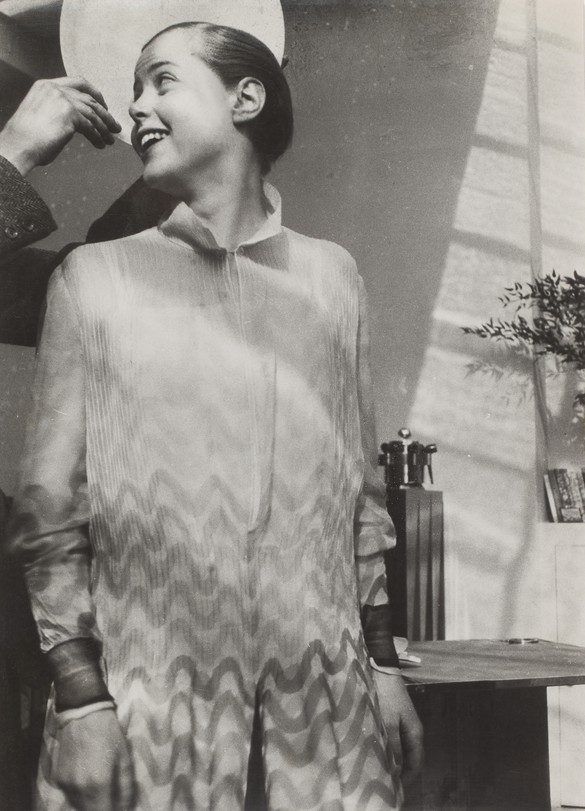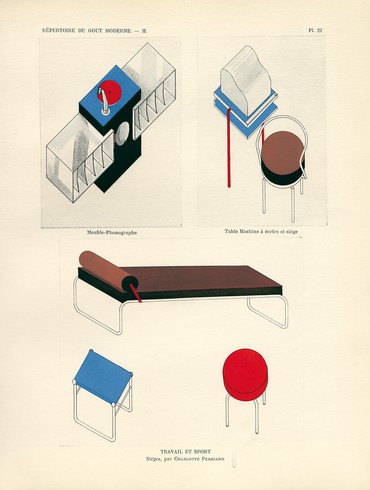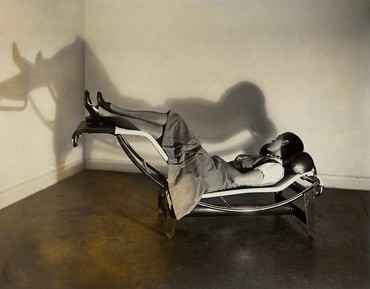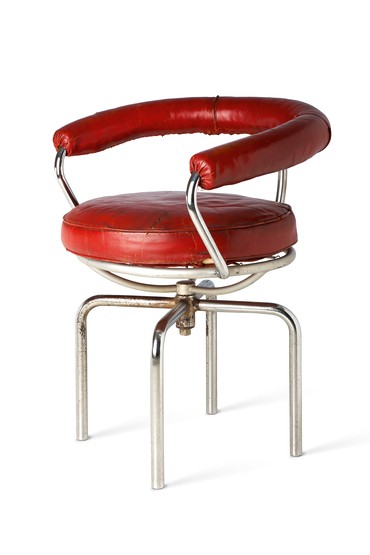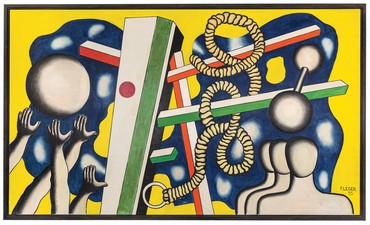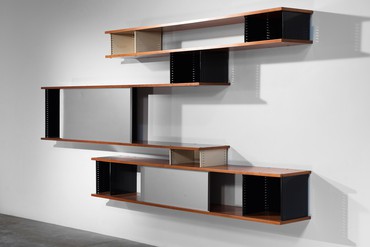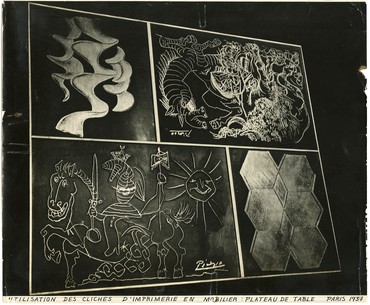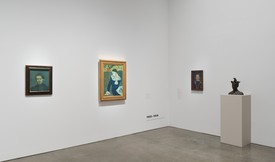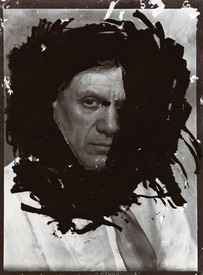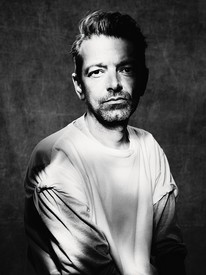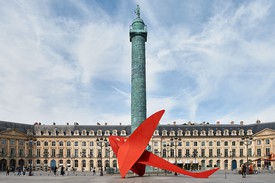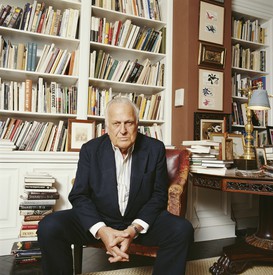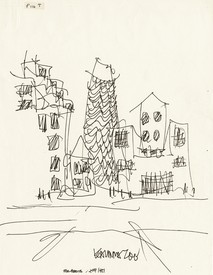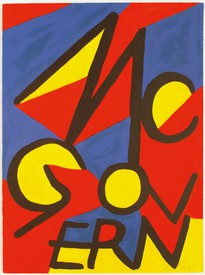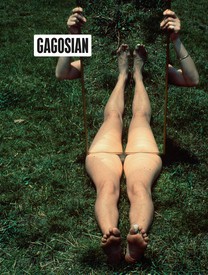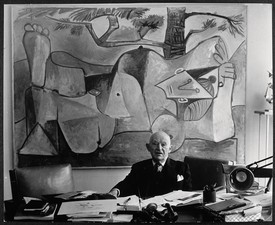
The Paris-based writer William Middleton is the author of Double Vision, a biography of the legendary art patrons and collectors Dominique and John de Menil, published in 2018 by Alfred A. Knopf. He has contributed to such publications as W, Vogue, Harper’s Bazaar, Architectural Digest, House & Garden, Departures, Town & Country, the New York Times, and T. Middleton’s most recent book is Paradise Now: The Extraordinary Life of Karl Lagerfeld published by HarperCollins in February 2023.
“Art is in everything,” insisted Charlotte Perriand, the pioneering French architect, designer, and multidisciplinary creative force. “It is in a gesture, a vase, a cooking pan, a glass, a sculpture, a piece of jewelry, a way of carrying yourself. Making love is an art.” Perriand, whose work is a high point of French modernism, had a broad vision of creativity. She termed it “synthesis of the arts,” an approach that expanded to include all of the fine and applied arts. Throughout the seven decades of her career, this idea became her manifesto.
On the occasion of the twentieth anniversary of Perriand’s death, the Fondation Louis Vuitton, Paris, is giving her a major retrospective, Le monde nouveau de Charlotte Perriand 1903–1999 (titled in English Charlotte Perriand: Inventing a New World) [October 2, 2019–February 24, 2020]. An ambitious exhibition four years in the making, it brings the full scale of her vision into focus for the first time. “Shortly after she died,” says Pernette Perriand Barsac, Perriand’s daughter and one of the show’s curators, “a friend of mine said that you have to wait fifteen or twenty years after the death of an artist to understand fully their place in art history.”
The Fondation Vuitton’s Perriand exhibition incorporates a vast amount of design and architecture—two hundred objects, seven “reconstitutions” of historic rooms, four re-created structures, and twenty-five architectural models—as well as two hundred works of art, lent by museums and private collectors around the world, by such artists as Georges Braque, Alexander Calder, Henri Laurens, Fernand Léger, Jacques Lipchitz, Joan Miró, and Pablo Picasso: paintings, sculptures, photographs, photomontages, and tapestries. “This is the largest exhibition we have ever dedicated to a single artist,” explains Jean-Paul Claverie, the director of the Fondation and for thirty years the cultural advisor to Bernard Arnault, chairman and CEO of the Vuitton parent company LVMH. “It marks the five-year anniversary of our Frank Gehry–designed building, which is itself a work of art. It is the first time we have focused on a female artist, and it is our first exhibition that incorporates design. If you ask me if this is a design exhibition, I will say that you are right. But I will also say that you are wrong.”
One curatorial goal was to contextualize Perriand’s work. The Fondation Louis Vuitton has had a relationship with Pernette Perriand and with her husband, Jacques Barsac, who is overseeing the ongoing publication of a multivolume catalogue raisonné. “When Pernette mentioned to me that the anniversary of her mother’s death was approaching, I spoke with Bernard Arnault and he was immediately enthusiastic,” Claverie explains. “We worked very closely together because we agree that the genius of Perriand, her extraordinary designs, took place in the context of a variety of movements—intellectual, social, political, artistic, and philosophical—during a time of profound transformation, the birth of modern society in the twentieth century. This had been suggested in earlier exhibitions but not developed in detail.”
The paintings and sculptures, selected for their connections with Perriand, explore her sense of a “synthesis of the arts”—in fact that was the exhibition’s working title. “The term is connected to the nineteenth-century utopian ideals of a total work of art,” says Olivier Michelon, the Fondation’s chief curator, “but Perriand makes the concept more precise. It is not a totality of art but a union of different artistic expressions, integrating a vast range—of works, of artists, of media—within a universal need, the lived environment.” As Jacques Barsac suggests of his mother-in-law, “Every time Charlotte presented her work, she included tapestries by Le Corbusier, paintings by Léger. Whenever she organized an exhibition, she called her friends—Miró, Calder, etc.—to loan works. She believed that art should be everywhere, that it needs to be part of daily life.”
The tone is set from the first galleries, where two pieces in tubular steel—the iconic reclining lounge chair Chaise longue basculante, B306 (1928), and the equally significant swiveling armchair Fauteuil pivotant, B302 (1927), stand in front of a monumental machine-age painting by Léger, Le transport des forces (Transport of forces, 1937), and Picasso’s Femmes devant la mer (Women by the sea, 1956), underscoring the designer’s connection with the artists and her fascination with nature. “Right away, you see where the exhibition is going,” Barsac explains. “Without Picasso, you cannot understand modern architecture. When you see Charlotte’s chaise longue, chair, and tables in front of that immense Léger, you cannot imagine the design without the art—it is a global vision.”
On an adjacent wall, Collier roulement à billes chromées (1927)—a silver choker made from automotive ball bearings that Perriand not only designed but wore—is placed next to a Léger painting, Nature morte (Le mouvement à billes) (Still life [Movement of ball bearings], 1926), which shows the same objects. Perriand’s 1925 drawing and watercolor of the American dancer Josephine Baker, whose sense of freedom fascinated the designer, hangs next to Calder’s Josephine Baker (III) (c. 1927), a wire sculpture of the same subject.
A few steps beyond is one of the complete interiors, La maison du jeune homme (House for a young man), a rigorous reconstruction based on drawings and archival documents. Originally built for the 1935 Exposition Universelle in Brussels, the rooms were intended to show how a young bachelor could live and work. A sixty-three-square-meter space (about 680 square feet), it encompassed a studio apartment and an adjacent gym. Perriand, who worked closely with Léger on the concept, intended it to allow a range of artistic disciplines as well as activities of health and sport, which were vital to her. The living and office space included modernist metal furnishings, a large wooden desk, an armchair in wood and straw, and a large blackboard. She herself created a socially conscious photomontage depicting the relationship between humanity and progress, and she placed a Léger painting of an aloe plant on a wall with shelves containing objects found in the forest and on the beach. “One of the great objectives of this exhibition is to be able to re-create this talent she had that was both spatial and discursive, being able to create a dialogue between space, objects, and bodies,” explains Michelon. “Perriand was not a painter or a sculptor but she was an artist, not only as an architect but as we would now think of an installation artist.”
One of the greatest elements of La maison du jeune homme is also one of the highlights of the exhibition. Along the top wall of the adjacent gym was a massive painting by Léger, La salle de culture physique. Le sport (Exercise room. Sport, 1935). Over seven feet tall and thirteen feet wide, it is a vibrant abstract work in vivid yellow, blue, red, and green. The arms of a couple of players reach for a volleyball, a gymnastic rope loops around a climbing rack, a barbell floats in the air, and a group of three athletes prepares to enter the action. Le sport has not been seen publicly since the 1930s. “We thought it had disappeared,” says Claverie. “We were lucky to find it, in a private collection in Palm Beach.” Not only did Claverie and his team track down the painting, and convince a very discreet collector to allow them to ship it to Paris, but they placed it in its intended position, soaring above the space. “It is undeniably one of the strongest moments of the exhibition,” says Michelon. “Léger’s canvas becomes like a cross between a studio painting and big-screen cinema.” Pernette Perriand is equally enthusiastic, noting the stir caused by the painting’s arrival in the galleries in September. “Charlotte asked him to do this painting,” she says of her mother and Léger. “This is the first chance to see it since 1935—I don’t know whether it’s also the last. And it is extraordinary.”
Although Perriand’s work is certainly known in the design world, the scale of her contributions has not been clear to the wider public. “In my life, I have always found great comfort in the world of art and my relationship with artists as I have navigated the paths of my own career,” explains Gehry, in an essay, “Charlotte and I,” that he insisted on contributing to the exhibition catalogue. “My lack of awareness of the breadth of her work is a travesty, and I am sure many share this oversight. Her work has genuinely enlightened me and will serve as an inspiration in my own future work.”
Patrick Seguin, who opened his eponymous Paris design gallery in 1989, has specialized in the work of Perriand and the great French modernists Jean Prouvé, Le Corbusier, Pierre Jeanneret, and Jean Royère. He is convinced that Perriand’s design is not just important historically but vital for today. “Charlotte Perriand has now found her place in museums and in the most prestigious collections,” Seguin explains. “The interest has increased gradually over the decades, due to international exhibitions and the evolution of style. And because her work was in perfect harmony with the modern art of its time, it is able to have the same rich dialogue with contemporary art, which also helps explain her popularity with today’s collectors.”
The Fondation Vuitton stresses the timelessness of Perriand’s mission. “Our goal with this exhibition is to position Charlotte Perriand as someone who is still contemporary,” Claverie says. “In her work and her life, she explored the role of women and feminism, the relationship with international cultures, and our relationship to nature and the environment. All of these engagements are completely contemporary—they could just as easily be expressed by a twenty- or thirty-year-old woman today. She was profoundly visionary, avant-garde, and we want the exhibition to make that clear.”
Perriand was born and raised in Paris, the daughter of a tailor and a seamstress. “Her parents were originally from the country but they worked in the field of luxury, so there was a sense of quality, an appreciation for beautiful fabrics, beautiful craftsmanship,” explains Barsac. Her drawing talents were clear during high school, and from 1920 to 1925 she was a student at the Union Centrale des Arts Décoratifs, studying the applied arts as well as painting and drawing. Two of her student projects—the binding of an architectural book by Paul Valéry, Eupalinos ou l’architecte, and a wrought-iron gate—were displayed at the 1925 Exposition Internationale des Arts Décoratifs et Industriels Modernes, the event that gave the world the term “Art Deco.” Within two years she had broken with the more decorative school, pursuing functional furniture designs in sheet metal and tubular steel. She designed the interior of her own small atelier and apartment, tucked into an attic on the place Saint-Sulpice, and joined the architectural office of Le Corbusier and Jeanneret, Le Corbusier’s cousin, where she was responsible for residential interior furnishings and furniture from 1927 until 1937.
In 1929, Perriand was a founder of the Union des Artistes Modernes (UAM), the French answer to the Bauhaus, joined by such other modernists as Prouvé, Le Corbusier, Pierre Barbe, Pierre Chareau, Sonia Delaunay, Eileen Gray, René Herbst, Robert Mallet-Stevens, and Jean Puiforcat. In 1930 she met Walter Gropius and Léger, who became a very close friend and joined the UAM. That year, at the first public exhibition of the UAM group at the Musée des Arts Décoratifs in Paris, the metal furniture credited to Le Corbusier, Jeanneret, and Perriand was shown for the first time. Seven pieces were promptly produced by Thonet, including four that Perriand had created entirely.
By 1930, she was designing furnishings for Le Corbusier, including those for his Villa Savoye, west of Paris, and overseeing construction of her first complete work of architecture, an airline building at Le Bourget that would become the earliest Air France terminal. The 1930s marked the beginning of Perriand’s political engagement: along with figures such as André Gide, Louis Aragon, André Breton, Max Ernst, Robert Capa, and René Crevel, she joined the Association des Écrivains et Artistes Révolutionnaires, a leftist group that advocated for revolutionary acts in culture. In those years she made two trips to Moscow, where she encountered the Russian avant-garde; to Cologne, where she met the German modernists; and to Athens, to participate in the Congrès Internationaux d’Architecture Moderne, a group of progressive European architects. In 1932 she moved from the place Saint-Sulpice into a photographer’s atelier in Montmartre, above the studio of Léger, where she would work with the artist and Jeanneret on her photography—primarily images of rocks, shells, and tree trunks that she would find on walks in forests around Paris and shoot in place or back in her studio.
In 1936, Perriand met Picasso and Josep Lluís Sert, architect of the pavilion of the Spanish Republic at the Exposition des Arts et Techniques dans la Vie Moderne, in Paris in 1937. Sert’s building housed Picasso’s Guernica that summer. In 1938, she worked on her first projects in the Alps—interiors and architecture—and designed such innovative pieces as a free-form desk for her studio in Montmartre, and, for the editor of the daily newspaper Ce soir, the Boomerang desk and a coffee table, which included engravings by Picasso and drawings by Léger. As World War II approached, she worked with Prouvé and Jeanneret to develop a wide range of low-cost furniture that could be produced during the war. In 1940, at the invitation of the Japanese minister of commerce and industry, she made her first trip to Tokyo. She would spend two and a half years in Japan, a stay that had a profound impact on her aesthetic.
In 1943, Perriand settled in French Indochina (today Vietnam), where she was the inspector of applied arts for the French colonial administration. There, she met and married Jacques Martin, director of French economic affairs in Indochina, and gave birth to their daughter, Pernette. After she returned to Paris, in 1946, her practice expanded exponentially during the period of postwar growth. She designed interiors for Georges Monnet, founder of the European Union, and for the author Louise de Vilmorin and other clients; worked on furnishings for Le Corbusier’s Cité Radieuse in Marseilles; and designed interiors for Air France offices from Tokyo to Brazzaville to London. In 1952, she contracted with Prouvé to collaborate on furniture, reinvigorating his practice and producing some of the great designs of 1950s France. In 1956, Perriand designed the interiors for the Galerie Steph Simon, on the boulevard Saint-Germain, soon to be the premier design gallery in Paris. Perriand and Prouvé were the stars of the gallery’s roster and she was the artistic director, conceiving the space’s installations for a decade.
On her return from Asia, Perriand began living and working in an apartment on the rue Las Cases, a small, charming street in the elegant Faubourg Saint-Germain. In 1959, in the nineteenth-century building across the street, a two-car garage came onto the market. It was a sixty-square-meter space with a ceiling height of four meters (about thirteen feet), with two large garage doors opening onto the street. She decided to buy it and turn it into her office. Perriand converted the back door, off the building’s lovely courtyard, into the entrance, leading first to a living space: black stone floors, an open kitchen with a large rectangular wooden table, and a stairway of simple wooden planks, anchored into the wall but giving the impression of floating, that went up to a sleeping loft. Beyond, the loftlike main room, with the same black floors, had white walls, oak bookcases and work tables, and Prouvé chairs. On the far wall Perriand converted the garage doors into two plate-glass windows with, on the exterior, a horizontal metal grill on the bottom third for privacy. It became a wall of windows, with floor-length white sheers filtering the northern light, making it resemble an artist’s atelier.
“I did not know what to expect when I visited Charlotte Perriand’s apartment for the first time,” remembers Gehry. “Sure, I knew about her beautiful furniture designs and her work with Le Corbusier, but I was not prepared for what I experienced firsthand: her mastery of space and composition. Everything was exquisitely composed at the human scale, immediate but not contrived. It was clear to me that she understood sculpture in the highest sense of the word, as the relationship between objects in the world.”
The poetic rooms on the rue Las Cases are now the Perriand archives, where Pernette Perriand and Jacques Barsac work to secure her legacy. “People often forget, or stories are repeated, myths are created,” says Pernette Perriand. “Everything Jacques has done is based on archival documents.” Barsac, formerly a documentary filmmaker, left his career to join his wife in processing the archives’ mass of information and overseeing the publication of books—one on Perriand’s work as a photographer, another on her production in Japan, as well as the catalogue raisonné. “It is only through the archives that the real story can be established,” Barsac says. “Even though we had a very good sense before, to be able to plunge into the archival material, to study it in a comprehensive way, to have these four volumes of the catalogue raisonné—now we can show definitively what she accomplished.”
The fourth and final volume of the raisonné, covering the years 1968 to 1999, is being published in conjunction with the exhibition. The 528-page tome, with 800 illustrations, covers a remarkable burst of productivity in the final decades of Perriand’s career. It includes her design of the Île Saint-Louis apartment of noted art historian, curator, and dealer Maurice Jardot (1967–87); the Galerie Louise Leiris, founded by Daniel-Henry Kahnweiler, the first great Picasso dealer (1989); and an open-air Japanese tea house on the grounds of the Paris headquarters of unesco (1993). Her greatest work also took place in those years, a series of Alpine ski resorts in the Val-d’Arc, in the Savoie (1967–88)—essentially an entire city built from scratch, with 30,000 beds across three sites. Perriand was the architect and urban planner, as well as designing most of the interior furnishings. The ensemble is a masterwork of humane modernism.
Given the vastness of Perriand’s architectural output, the incorporation of art in the Vuitton exhibition is particularly impressive. “All it required was following the example of Charlotte Perriand,” Michelon points out. Claverie is convinced that to fail to fuse architecture and art would have been unfair to the subject: “To celebrate an artist is also to respect them, to understand the depth of their vision, their engagement,” says the director, “and this was hers. We can’t talk about Charlotte Perriand without respecting this line that she traces throughout her career, this dialogue, this ‘synthesis of the arts.’”
Le monde nouveau de Charlotte Perriand / Charlotte Perriand: Inventing a New World, Fondation Louis Vuitton, Paris, October 2, 2019–February 24, 2020
All images courtesy Fondation Louis Vuitton, Paris
